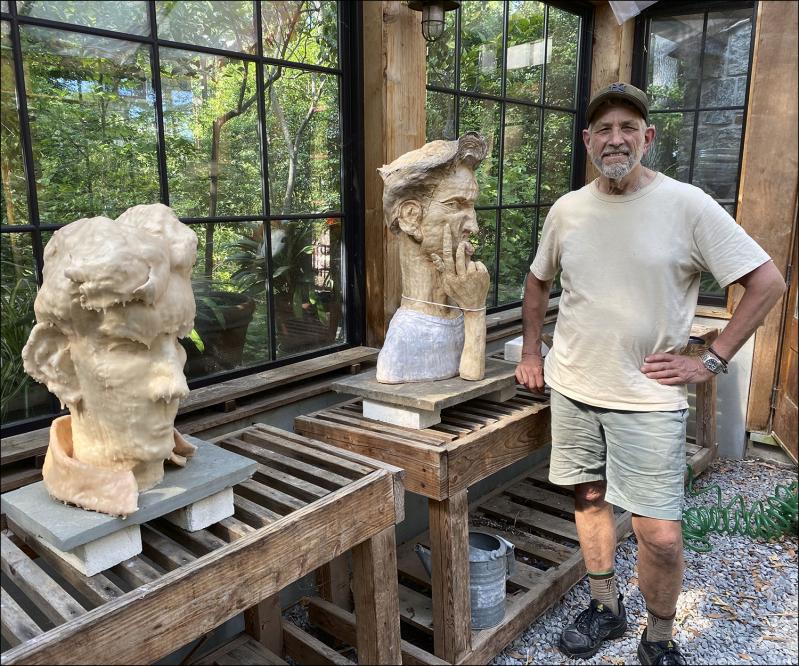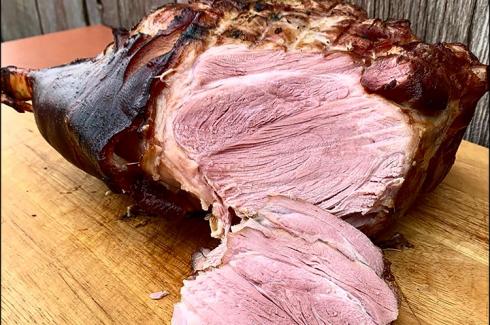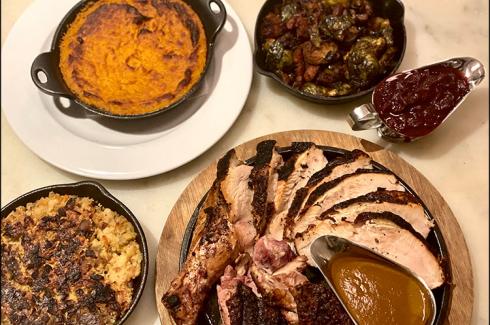Ted Tyler likes to make things. Some of them, ceramic sculptures, he fires in a massive outdoor kiln he built on his Springs property. Others, fabric designs and wall coverings, he creates by hand in his Chelsea loft. The ceramics came first, gave way to the fabric work, and only since moving to Springs and building the kiln has he been doing both.
Growing up in a Maryland suburb of Washington, D.C., during junior high school he took himself downtown to the Corcoran School of Arts, where he took ceramic classes for five years. “It was strictly my own interest that took me there,” Mr. Tyler said during a conversation outside of his house and studio, which overlook Accabonac Harbor.
“There was a Japanese guy, Teruo Hara, who ran the department, so it was all kind of Japanese. That’s how I wound up with the Japanese influence in my work. He had a house in Virginia, and in high school I used to go out there on the weekends and work with him. So it was a great learning experience for me.” (In 1968, The Washington Post called Hara’s work “the most exciting examples of glazed ceramics being produced in the United States today.”)
In 1970, Mr. Tyler went to Boston to study ceramics at the School of the Museum of Fine Arts. At the time he was making pots. “The guy who ran the department, he was a fixture in 1960s ceramics, said I should quit making pots and do more sculptural stuff.”
After two years in Boston, he moved to San Francisco, where he studied at the Art Institute there until 1976. “It was all sculpture work,” he said. “I don’t think they even made pots there.” By then he had found his artistic niche — but not for long.
“I went to New York and got a big loft on 23rd Street, and it was going to get me nowhere.” He had a friend working in the Garment Center for a company that made printed fabric for a collection of women’s clothing. “He said if I put together a portfolio of textile prints he would get them to hire me as a print designer. So I ran around to all the stores, looked at all these printed dresses,” and within a week he put together a portfolio and, in the late ‘70s, got the job.
Because he had a spacious loft, he soon built printing tables and taught himself how to print fabric from his own designs. He then assembled a collection of hand-printed fabrics for interiors. The result was the launch in 1983 of TylerGraphic, which has been producing fabrics and wall coverings ever since. By that time he had stopped making ceramics altogether.
Since the company’s inception, Mr. Tyler has been refining his “wet on wet” screen printing process, “which imbues the product with a colorful sense of life and movement like no other work currently on the market,” according to its website. His clients have included Mary McFadden, Calvin Klein, and Ralph Lauren, and three of his textiles are in the Cooper Hewitt, Smithsonian Design Museum.
He ran the business until Covid, doing all the textile design work. During those years he had people working in the loft on 23rd Street because the company printed so many fabrics. Since the pandemic, he has downsized the business, accepting orders from some old clients, but without full-time employees.
Mr. Tyler began coming to the East End during summers in the ‘80s and eventually bought a house on Miller Lane in East Hampton, where he lived for 10 years. During that time he purchased two and a half acres on Accabonac Harbor. “I just spent a lot of time on the property after I bought it, designing and redesigning the house until I finally built it in 2000.”
“Then I was here and I started thinking about ceramics again. I hadn’t done any ceramics in over 20 years.” He had to do the fabrics to support himself, but he built his ceramic studio and his kiln and “went way back to the beginning and started making pots. So I did pots for maybe five or six years until I got to a point where I felt the pots I was making were as good as they could ever be.”
Once he returned to the idea of working sculpturally, that is, creating nonfunctional ceramics, he was influenced by exhibitions of work by two very different artists, Giorgio Morandi and Philip Guston. In 2023 he had an exhibition of those works at the Arts Center at Duck Creek in Springs.

Of Morandi’s paintings of vases, he said, “I was looking at them and wondering what would those vessels look like in 3-D. So I started making the kind of vessels you see in a Morandi drawing or painting and arranging them in tableaus.” The Duck Creek show included “Grande Morandi,” a large-scale installation that was sited outdoors.
As for Guston, he said, “I think of his paintings as more like sculpture. I was looking at the cone shape he uses, and all those big long fingers, so I started doing some sculptural pieces that were a mixture of sculpture and pots, using those shapes.”
When those pieces — titled “Circus Series” — were shown at Duck Creek, a press release noted that “the cartoonish forms balance precariously on thin or bending legs, moving toward and away from each other, with glazed gestures that recall Abstract Expressionist motifs.”
Never one to stand pat, after thinking for a long time about portraits, Mr. Tyler embarked on a series of busts last winter, most based on self-portrait drawings he did many years ago.
Of the three finished portraits in his gallery space, each involves a different process. One is raku, a Japanese technique known for its unpredictable, often dramatic results. A second head is made of wax, and the third was not glazed but rather painted in watercolor.
There are more portrait heads underway in his studio. The forms of all the busts are slightly attenuated, in some cases almost deformed. One in particular seems to burst into dramatic life with a frown and outstretched tongue. Another has limbs with oversized fingers emerging from slender arms. The busts tread a compelling line between resemblance and an exaggeration of expression and modeling that vividly animates them.
Last month he showed several Guston-influenced works, some of which were reassembled from cracked pieces, at HaubrichArt in Springs. “The idea of Japanese ceramics is that everything is kind of wonky, and stuff breaks in ceramics a lot. If something breaks but I like it, I’ll glue it back together, and the cracks and shattering are just part of the process. If it visually makes an addition to the piece or doesn’t detract from it, then the fracturing doesn’t matter, because it’s not a functional thing.”
In the end what marks Mr. Tyler’s ceramic work is its fearlessness, his willingness to try different materials and techniques and pivot from the calm, measured quality of Morandi to the whimsical forms of Guston to the aggressively assertive self-portrait busts.




